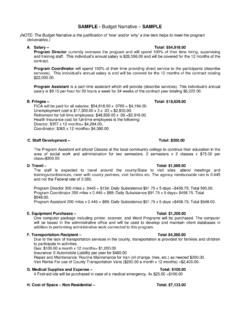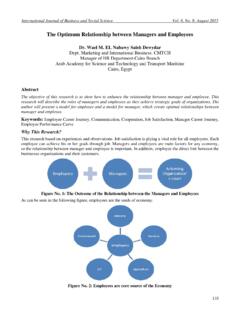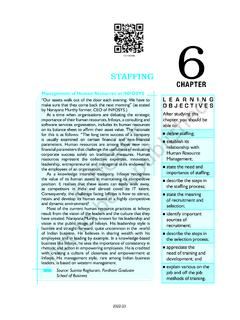Transcription of CompassPoint Nonprofit Services
1 CompassPoint Nonprofit Services Page 1 of 39 Supervisor Roles and Responsibilities: Helping People Succeed CompassPoint Nonprofit Services 500 12th St, Suite 320 Oakland, CA 94607 ph 415-541-9000 fx 415-541-7708 Web: e-mail: Revision Date: July 6, 2012 CompassPoint Nonprofit Services Page 2 of 39 Disclaimer All material is provided without any warranty whatsoever, including, but not limited to, the implied warranties of merchantability or fitness for a particular purpose. Any names of people or companies listed in this book or in its companion computer files are fictitious unless otherwise noted. Copyright 2013 CompassPoint Nonprofit Services unless otherwise indicated. All rights reserved. This publication, including any companion computer disk, or any component part thereof, may not be reproduced or transmitted in any form or by any means, electronic or mechanical, including photocopying, recording, storage in any information retrieval system, or otherwise, without the prior written permission CompassPoint , 500 12th St, Suite 320 Oakland, CA 94607 ph or the author.
2 CompassPoint Nonprofit Services Page 3 of 39 Learning Objectives Understand the roles and responsibilities of a supervisor (understanding the fundamentals of the supervision framework) to foster excellent performance that supports individual and organizational needs. Know how to establish and communicate performance standards and expectations using behavioral terms. Apply a feedback framework to give constructive and supportive feedback within a supervisory context. Know how to establish work plans that include performance and professional development goals. Know how to create strategies for effective supervision and performance meetings. CompassPoint Nonprofit Services Page 4 of 39 Introduction CompassPoint Philosophy and Values 1. People are the most important resource in a community based Nonprofit supervision plays a key role supporting the success of people working in nonprofits. 2. Shared leadership leadership is a process and happens at every level throughout an organization.
3 3. Asset-based/strength-based every individual has different talents and strength that make them unique. Organizations and teams who recognize and deploy people based on their strengths can achieve higher levels of performance. 4. Respect regardless of the situation, all people should be treated with respect. 5. Performance is tied to outcomes performance is not judged on personal preferences or whims, but on objective outcomes tied to the organization s needs. 6. A culture of providing ongoing and timely feedback to support performance improvement and personal growth is critical for trust and relationship building. 7. Our multicultural values live and breathe in our organization and in our work with Nonprofit leaders, Nonprofit organizations and the Nonprofit field as a whole. Our work is and rooted in and strengthened by ever-expanding community knowledge of and relationships to diverse communities. Our programs are responsive to diverse ways of learning and meet people where they are.
4 We partner with others to promote collective learning and to build the capacity of nonprofits as agents of multicultural responsiveness and equity. CompassPoint Nonprofit Services Page 5 of 39 Tools to Manage and Implement Change Changing behavior or integrating a new skill requires that we look at three organizational dimensions: skills, systems, and culture. An individual can learn new skills, but those skills are applied within an organization. The organization may or may not have the necessary systems in place to support and operationalize those skills successfully. The culture of the organization will also impact one s ability to apply skills. Do the values and practices inherent in the culture of the organization foster or hinder the process? CompassPoint Nonprofit Services Page 6 of 39 Each of us grapples with how to manage change in an organization, introduce new information or galvanize support for a new idea. In these situations, consider the following: Authority: What areas/projects in your work do you have the authority to decide upon and act on those decisions?
5 When do you make decisions on your own, when do you include others in the decision? Influence: What areas of organizational decision making are you able to influence when you do not have authority to make the final decision? How do you influence them? Concern: where are you limited or have no authority, where you can t influence? concern authority influence CompassPoint Nonprofit Services Page 7 of 39 Overview of Performance Management The purpose of an organization s performance planning and review process is to guide, support, and develop staff to ensure both employee and organizational success. It is an ongoing and cyclic process that runs on an annual basis and is shaped by the organization s needs. The performance management system fosters ongoing two-way communication between employees and managers; supports the development of clear, consistent, and measurable goals linked directly to the organization s core values and competencies; helps to articulate and support training needs and career development; and establishes the criteria for making reward and recognition decisions.
6 Effective performance management begins with respect for one another and ends with excellence in performance. It is the responsibility of supervisors to communicate on an ongoing basis with their employees. These conversations should be grounded in honest communication and provide staff with clear role expectations, feedback, identify performance improvement, development opportunities, and career possibilities. Each employee has a responsibility to participate fully in these conversations, be sure they understand their role responsibilities and expectations, and communicate any obstacles or training needs in order to perform their role at an optimum level. Performance management should be happening all year long and culminates with a summary review assessment that should bring closure to the performance period and provide a basis for performance management for the next period. CompassPoint Nonprofit Services Page 8 of 39 CompassPoint Nonprofit Services Page 9 of 39 Executive leadership is responsible for ensuring that a performance management system is in place and being used effectively, specifically this entails: Setting organizational strategy (together with the Board of Directors) Updating the employee handbook and communicating any changes Annually, in writing, communicate: o Current strategy and plans o Reminders and guidance to managers of deadlines to complete employee s annual goal setting and reviews Using and modeling the performance management process, practices, and tools Ensuring evaluations of their staff are well written and accurate by reviewing them and providing feedback and coaching as appropriate Reviewing evaluations of employees and providing feedback to supervisors Supervisors are responsible for.
7 Aligning individual performance expectations with organizational goals Developing performance goals collaboratively with their direct reports Ensuring that performance goals are clearly communicated and current Providing fair, constructive, and timely feedback towards performance expectations and goals Providing assistance, guidance, and coaching support as needed Ensuring that staff have professional development plans in place Conducting performance evaluations according to established systems and policies Employees are responsible for: Communicating work load challenges Communicating progress towards performance goals Identifying and communicating professional development needs and opportunities Achieving performance and professional development goals as identified in individual work plans and individual development plans. CompassPoint Nonprofit Services Page 10 of 39 The Supervision Framework The supervisor s overall role is to communicate organizational needs, oversee employees performance, provide guidance, support, identify development needs, and manage the reciprocal relationship between staff and the organization so that each is successful.
8 CompassPoint Nonprofit Services Page 11 of 39 Discussion Exercise ORGANIZATIONALLY 1. What is working well within your organization s performance management system? 2. What areas would you highlight for changes or improvements? AS A SUPERVISOR 3. Where are you most strong as a supervisor? 4. What areas of supervision are challenging for you? 5. What should you highlight for improvement? CompassPoint Nonprofit Services Page 12 of 39 Setting & Communicating Expectations Group Exercise: Brainstorm a list of expectations you have for the people you supervise. 1. 2. 3. 4. 5. 6. 7. 8. 9. 10. CompassPoint Nonprofit Services Page 13 of 39 Communicating Expectations In order for employees to understand what is expected of them, you should communicate expectations in terms of behaviors by explaining what it looks like or sounds like when an employee is, for example, behaving professionally, treating co-workers with respect, or being accountable for his or her work.
9 Often, expectations are set by the organization in the form of performance standards: conditions that exist when the job is performed acceptably in terms of quality, quantity, time, cost, impact, and process or method of doing. They are generally based on the organization, not the person in the job. They are different from specific goals which are set for an individual, and change over time, rather than the job. They enable individuals to differentiate between acceptable and unacceptable results. Examples of performance standards: Follow through: Enter all donor communications data within one week of contact. Accuracy: All client statistical reports shall be 100% error free. Punctuality: Be ready to receive clients at 9am every day. Responsive or Good Customer Service: Respond to all phone messages and emails within 48 hours. Excellence: Achieve an average score of or higher on program participant evaluations. Clean: Keep kitchen clean to health code specifications.
10 Friendly: Greet all clients and visitors with standard greeting when they arrive and offer them a glass of water or coffee. Engagement: Actively participate in meetings; offer comments; ask questions; refrain from doing other work in the meeting ( using PDA, tweeting, writing, or using laptop). Good Communication: Check in with principal of each school to update them on program status and issues within the first week of every month during school year. CompassPoint Nonprofit Services Page 14 of 39 Expectation Behavior Professional Arrive to work and all meetings on time; adhere to dress code guidelines; ensure all written communications are error free and use appropriate tone that considers the varied audiences and client groups that we serve. Respectful Greet people in the hallways; treat colleagues as internal customers; clean up your area and do your part to keep the common area ( kitchen) clean. Accountable Meet all deadlines; come prepared to meetings with minutes from the last meeting, questions about the agenda and ideas to contribute to the topic; respond to requests in a timely manner.








